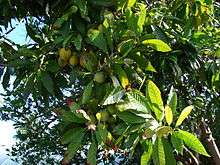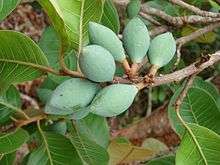Pouteria
Pouteria is a genus of flowering trees in the gutta-percha family, Sapotaceae. The genus is widespread throughout the tropical regions of the world. It includes the canistel (P. campechiana), the Mamey sapote (P. sapota), and the lucuma (P. lucuma). Commonly, this genus is known as pouteria trees, or in some cases, eggfruits.
| Pouteria | |
|---|---|
 | |
| Canistel (P. campechiana) | |
| Scientific classification | |
| Kingdom: | Plantae |
| Clade: | Tracheophytes |
| Clade: | Angiosperms |
| Clade: | Eudicots |
| Clade: | Asterids |
| Order: | Ericales |
| Family: | Sapotaceae |
| Subfamily: | Chrysophylloideae |
| Genus: | Pouteria Aubl.[1] |
| Species | |
|
Many, see text | |
| Synonyms | |
|
Many, see text | |
Pouteria is related to Manilkara, another genus that produces hard and heavy woods (e.g. balatá, M. bidentata) used commonly for tropical construction, as well as edible fruit (such as sapodilla, M. zapota).
Uses

Many species, like Pouteria maclayana[2] have edible fruits and are important foods, seasonally. Some are being commercially collected and sold on local markets or packed in cans.
Pouteria species yield hard, heavy, resilient woods used as firewood and timber, but particularly in outdoor and naval construction, such as dock pilings, deckings, etc. Some species, such as abiu (P. caimito), are considered to be shipworm resistant; however, this depends on the silica content, which may vary from 0.0-0.9%. The weight by volume (at 12% moisture content) of Pouteria wood can be in excess of 1140 kg/m3 (71 lb/ft3; thus, the wood sinks in water. The wood of Pouteria species is prone to considerable movement and warping when it dries out, but in its main use, naval construction, this is not a problem, since the wood never gets really dry.
The vessel elements are relatively small and usually di- to quadriseriate; the medullary rays are fine and close together. Pouteria woods are capable of attaining an excellent polish using fine-grained sandpaper and possibly some wax. They can sometimes show an attractive figure of dark stripes against a sandy to mid-brown background colour. However, the wood is hardly used for furniture because it is so dense that items made from it would be difficult to transport. Moreover, it is nearly impossible to work using hand tools. Even using power tools, working these woods presents some problems, as well, but given some patience and practical knowledge, these can easily be solved.
For the silica to be effective against shipworms, it needs to dry to some degree to harden. When the wood is continually waterlogged, this process may take place very slowly or not at all, leaving the wood vulnerable.
Pouteria foliage is used as food by some Lepidoptera caterpillars, including those of the dalcerid moth Dalcera abrasa, which has been recorded on P. ramiflora. The fruits are important food for various animals, such as the rock-haunting ringtail possum (Petropseudes dahli).
Due to habitat loss and in some cases overexploitation, many species of Pouteria are threatened. At least 10 are close to extinction, and one – the Rio de Janeiro pouteria (P. stenophylla), which grew near Rio de Janeiro in Brazil, is now extinct.
Systematics and taxonomy
Pouteria is a "wastebasket taxon", and its size is continually being expanded or decreased. The segregate Labatia, described by Olof Swartz in 1788 and named after the French botanist Jean-Baptiste Labat, was maintained as a distinct entity until the 1930s, when it was finally synonymized with Pouteria for good. Most segregated genera that were eventually merged with Pouteria again were established by Henri Ernest Baillon and Jean Baptiste Louis Pierre.[1]
Selected species
Formerly placed here
- Englerophytum magalismontanum (as P. magalismontana)
- Synsepalum dulcificum (Miracle Fruit, as P. dulcifica)
Synonyms
Due to the uncertainty regarding its actual content, the number of synonyms of Pouteria is massive – at least when the genus is defined in the expanded sense:[1]
|
|
In addition, the following genera are sometimes included in Pouteria too:[1]
- "Beccariella" Pierre (non Cesati: preoccupied)
- Boerlagella Cogn.
- Planchonella Pierre
- Sersalisia R.Br.
- Van-royena Aubrév.
Footnotes
- USDA (2009)
- Paper from the Research School of Pacific and Asian Studies
- Little Jr., Elbert L.; Roger G. Skolmen (1989). "ʻĀlaʻa" (PDF). United States Forest Service. Cite journal requires
|journal=(help)
References
| Wikimedia Commons has media related to Pouteria. |
- United States Department of Agriculture (USDA) (1996): Germplasm Resources Information Network – Pouteria. Version of 2009-Mar-31. Retrieved 2009-Nov-15.